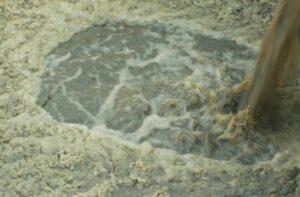 When wastewater enters a wastewater treatment plant it typically flows through a screen of varying sizes to remove large items like wood, rocks and debris. The resultant material then enters a primary settling tank where the sludge (the organic portion of the wastewater) settles. This is considered raw sludge or primary sludge and will still contain small particles, like grit, sand and rocks that were not removed during the screening process.
When wastewater enters a wastewater treatment plant it typically flows through a screen of varying sizes to remove large items like wood, rocks and debris. The resultant material then enters a primary settling tank where the sludge (the organic portion of the wastewater) settles. This is considered raw sludge or primary sludge and will still contain small particles, like grit, sand and rocks that were not removed during the screening process.
This sludge material can be produced from a variety of industrial processes, including water treatment, wastewater treatment or on-site sanitation systems. Primary or raw sludge pumping tends to be one of the toughest applications in wastewater treatment plants because this is where most of the grit and solids accumulate.
How Double Disc Pumps Handle Sludge
The main job of wastewater treatment plants is to separate the solids material from the water and return the treated clean water back into the environment. The primary sludge removal process is critical to the separations process and since it is the toughest application, many pump technologies cannot handle this application effectively due to rags, grit and other materials that settle out. The wrong pump technology in this application will lead to clogged and worn out pumps that results in poor performance, significant downtime, as well as high maintenance and spare parts costs.
The design of the PVP double disc pump combine positive displacement pumping with induced flow, enabling the pump to provide flexibility in fluid handling. Because of the pump’s non-close tolerance design, it can handle materials ranging in size from ½” to 2”, making handling sludge a lot easier.
A Unique Pump Design Makes It All Work
PVP pumps offer a unique design. The discs in the pump perform the duties of both diaphragm and valve, eliminating the ball check valves required by typical reciprocating pumps which are clogging points. The double disc pump creates a double-acting, non-clogging, pumping action, which is ideal for use in wastewater treatment plants where raw sludge and primary sludge are common.
Given the non-close tolerance design, the settled grit, sand and rags do not significantly increase the wear on the pump leading to long-term reliable installations. Also, since the discs in these pumps are not captive in the pump housing, flex fatigue failure (which is often found in captive diaphragm pumps) is eliminated. The hydraulic interaction between the discs in a double disc pump moves fluid from suction to discharge easily.
The large valve-like discs in double disc pumps allow solids, rags and plastics to pass without loss of pumping action. These elastomeric discs have large seating areas. These areas offer low internal velocities, which allow the pump to handle abrasive sludges and slurries and help to extend the pump wear life.
Uniquely suited to handle anything
The double disc pump design by Penn Valley Pump is uniquely suited to handle the tough application of primary and raw sludge pumps. With a non-close tolerance design and no check valves, the double disc pumps provide years of trouble-free operation with very low routine maintenance requirements. Which double disc pump can transform your installation?